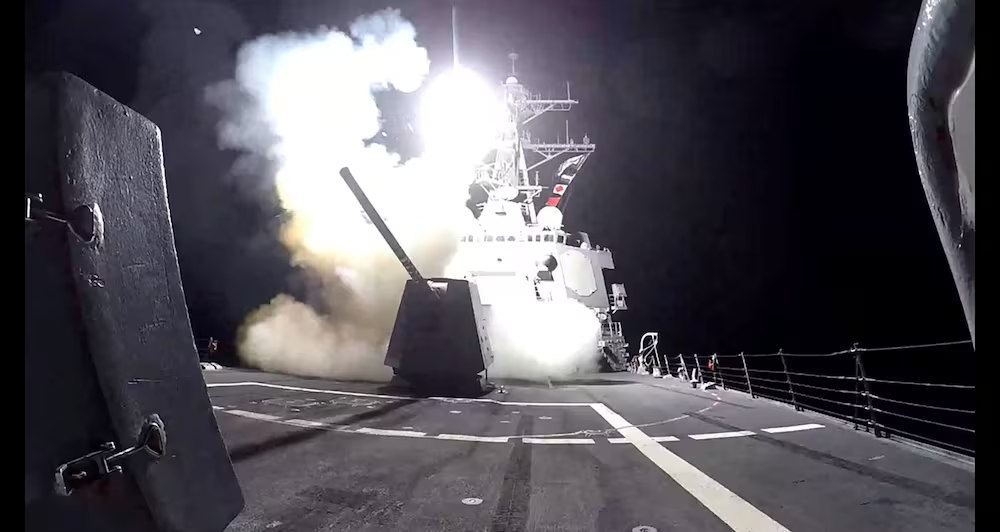Since the Hamas-Israel conflict broke out on October 7, 2023, Houthi forces in Yemen have launched missiles, unmanned aerial vehicles (UAVs) and other weapons at commercial ships and warships in the Red Sea and the Gulf of Eden almost every day.

Smoke rises from the British ship Marlin Luanda after it was hit by a Houthi anti-ship missile in the Gulf of Aden on January 27.
More than 20,000 commercial ships are estimated to pass through the Red Sea each year, including 150 tankers and large container ships, but container traffic through the waters has dropped by 67 percent and tanker traffic by about 50 percent since the Houthi attacks began last November. The Houthis have focused their attacks on Israeli-owned vessels or those headed to the southern Israeli port of Eilat, claiming to be on Hamas’ side in the conflict. Many shipping companies have been forced to reroute their ships around the southern tip of Africa.
“We haven’t been impacted, but strategically we haven’t restored the flow of goods,” said Gene Moran, a former US Navy captain.
Houthi suicide boat hits cargo ship
Quick or long fight?
Against this backdrop, the Biden administration has limited its military response to the Houthi attacks to avoid being drawn into a broader conflict in the Middle East. This means that US and allied warships have had to spend more time patrolling and protecting the Red Sea amid the ongoing attacks, according to The Wall Street Journal .
Last month, Avril Haines, the US director of national intelligence, said the US-led effort was not enough to stop the Houthis from targeting ships and that the threat would continue for a long time.
The longer the Houthi attacks continue, the greater the chance that a US warship could be targeted, said retired US Marine Corps general Frank McKenzie. “There’s always a chance that something could happen and one of our ships could be attacked, and that chance increases the longer we let this go on,” McKenzie said.

A Tomahawk cruise missile is launched from the US Navy's Arleigh Burke-class guided missile destroyer USS Gravely, towards the Houthis on February 3, 2024.
The US Navy said it has spent about $1 billion on munitions used to defend the Red Sea, conducting more than 450 strikes and intercepting more than 200 drones and missiles since November 2023. US officials worry that the conflict with the Houthis will put a huge strain on the US defense industry, which is already strained by the country's need to supply weapons to both Ukraine and Israel.
Earlier, Lieutenant General Alexus Grynkewich of the US Air Force said that the country's difficulty was determining the extent of the Houthi arsenal's losses after the attacks by the US and its allies, as well as the Houthi's resources before the start of the fighting, according to PBS.
Emily Harding, a senior fellow at the Center for Strategic and International Studies (CSIS), said Iran's weapons support for the Houthis appeared to be cheap and highly durable, while US weapons were expensive and had limited supply chains and logistics. "We want a quick game, and the Houthis want a long game," Harding said.
America both defends and attacks
Recently, the Houthis have used a new, fast anti-ship ballistic missile to attack targets in the Red Sea and the Gulf of Aden. To intercept a Houthi anti-ship ballistic missile, US sailors only have about 9 to 20 seconds to "detect, assess and make a decision to destroy the target," according to Business Insider , quoting Lieutenant Colonel Jeremy Robertson, captain of the guided-missile destroyer USS Carney.
Similarly, naval officers aboard the aircraft carrier USS Dwight D. Eisenhower, the destroyers USS Gravely and USS Laboon also acknowledged the threat from the Houthi group’s anti-ship ballistic missiles. In addition, according to CSIS analysis, the Houthis possess a sizable arsenal of anti-ship ballistic missiles, posing a challenge for the US and its allies in maintaining defenses against attacks from this type of weapon.
In addition to shooting down incoming missiles and UAVs, the US and other countries have also carried out a number of airstrikes targeting launchers, radar installations and other facilities used by the Houthis in their attacks.
Source: https://thanhnien.vn/houthi-gay-kho-cho-hai-quan-my-o-bien-do-nhu-the-nao-185240613174837152.htm






























![[Photo] National Assembly Chairman attends the seminar "Building and operating an international financial center and recommendations for Vietnam"](https://vphoto.vietnam.vn/thumb/1200x675/vietnam/resource/IMAGE/2025/7/28/76393436936e457db31ec84433289f72)




































































Comment (0)